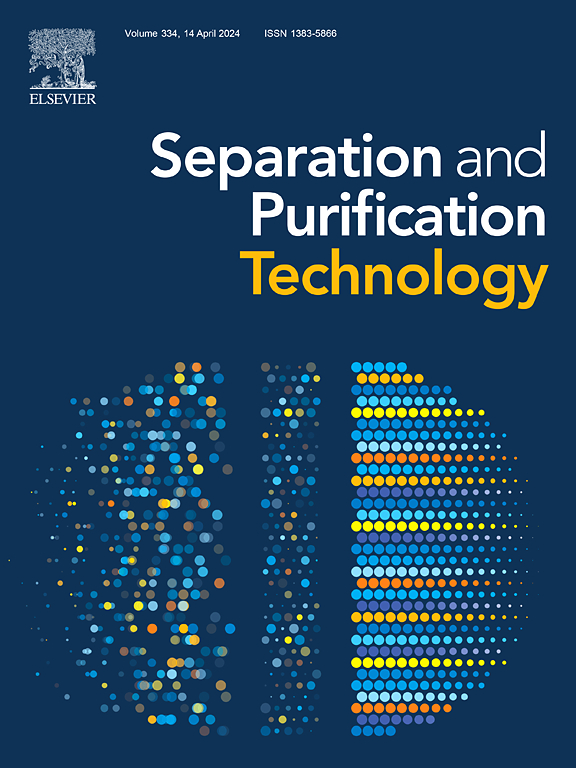钠离子介导的Pluronic f127 -果糖衍生水热碳的孔径调节以增强电容去离子性能
IF 9
1区 工程技术
Q1 ENGINEERING, CHEMICAL
引用次数: 0
摘要
以钠离子(Na+) -Pluronic F127配位配合物为模板合成了层次多孔碳(HPCs),并将其应用于电容去离子(CDI)。通过在Pluronic f127 -葡萄糖水溶液中加入NaCl进行水热碳化,HPC-8/12具有最大的比表面积(267.30 m2/g)和介孔体积(85.7 %)。与HPC-0/12相比,HPC-8/12在1 M NaCl水溶液中的比电容为94.22F/g。HPC-8/12随后与氧化石墨烯混合,通过湿纺加工成无纺布。然后在800℃的惰性气体中对这些织物进行热退火,制成CDI电极。所得的hpc -8/12 -石墨烯复合纤维在1.2 V的工作电压下,对KCl、NaCl和LiCl的盐吸附量分别为13.34 mg/g、18.78 mg/g和12.53 mg/g。Na+ -Pluronic F127配合物在热退火过程中完全降解,导致介孔尺寸增大,降低了离子传输阻力。此外,它们还引入了特定的Na+吸附位点。本研究证明了CDI技术选择性吸附Na+的潜力。本文章由计算机程序翻译,如有差异,请以英文原文为准。
Sodium-ion-mediated pore size regulation in Pluronic F127-fructose-derived hydrothermal carbons for enhanced capacitive deionization performance
Hierarchically porous carbons (HPCs) were synthesized using a sodium ion (Na+)–Pluronic F127 coordination complex as a template for application in capacitive deionization (CDI). By incorporating NaCl into the Pluronic F127–glucose aqueous solution during hydrothermal carbonization, the HPC-8/12 exhibited the largest specific surface area (267.30 m2/g) and mesopore volume (85.7 %). Compared to HPC-0/12, HPC-8/12 demonstrated a specific capacitance of 94.22F/g in a 1 M NaCl aqueous electrolyte. The HPC-8/12 was subsequently mixed with graphene oxide and processed into non-woven fabrics via wet-spinning. These fabrics were then thermally annealed in an inert gas at 800 ℃ to produce CDI electrodes. The resulting HPC-8/12–graphene composite fibers achieved salt adsorption capacities (SAC) of 13.34 mg/g for KCl, 18.78 mg/g for NaCl, and 12.53 mg/g for LiCl at a working voltage of 1.2 V. The Na+–Pluronic F127 coordination complexes completely degrade during thermal annealing, resulting in enlarged mesopore sizes that reduce ion transport resistance. Additionally, they introduce specific adsorption sites for Na+. This study demonstrates the potential for selectively adsorbing Na+ using CDI technology.
求助全文
通过发布文献求助,成功后即可免费获取论文全文。
去求助
来源期刊

Separation and Purification Technology
工程技术-工程:化工
CiteScore
14.00
自引率
12.80%
发文量
2347
审稿时长
43 days
期刊介绍:
Separation and Purification Technology is a premier journal committed to sharing innovative methods for separation and purification in chemical and environmental engineering, encompassing both homogeneous solutions and heterogeneous mixtures. Our scope includes the separation and/or purification of liquids, vapors, and gases, as well as carbon capture and separation techniques. However, it's important to note that methods solely intended for analytical purposes are not within the scope of the journal. Additionally, disciplines such as soil science, polymer science, and metallurgy fall outside the purview of Separation and Purification Technology. Join us in advancing the field of separation and purification methods for sustainable solutions in chemical and environmental engineering.
 求助内容:
求助内容: 应助结果提醒方式:
应助结果提醒方式:


